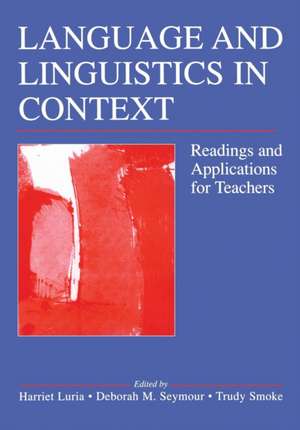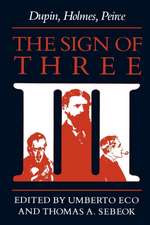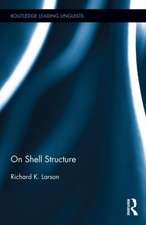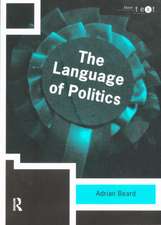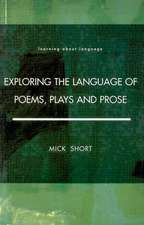Language and Linguistics in Context: Readings and Applications for Teachers
Editat de Harriet Luria, Deborah M. Seymour, Trudy Smokeen Limba Engleză Paperback – 16 sep 2005
*introduces basic linguistic concepts and current perspectives on language acquisition;
*considers the role of linguistic change (especially in English) in the politics of language;
*acknowledges the role of linguists in current policies involving language;
*offers insights into the relationship between the structure of language systems and first- and second-language acquisition; the study of language across culture, class, race, gender, and ethnicity; and between language study and literacy and education; and
*provides readers with a basis for understanding current educational debates about bilingual education, non-standard dialects, English only movements, literacy methodologies, and generally the importance to teaching of the study of language.
The text is organized into three thematic units – "What is Language and How is It Acquired?"; "How Does Language Change?"; and "What is Literacy?". To achieve both breadth and depth – that is, to provide a “big picture” view of basic linguistics and at the same time make it specific enough for the beginner – a selection of readings, including personal language narratives, is provided to both introduce and clarify linguistic concepts. The readings, by well-known theoretical and applied linguists and researchers from various disciplines, are diverse in level and range of topics and vary in level of linguistic formalism.
Pedagogical features: This text is designed for a range of courses in English and language arts, bilingualism, applied linguistics, and ESL courses in teacher education programs. Each unit contains a substantive introduction to the topic, followed by the readings. Each reading concludes with Questions to Think About including one Extending Your Understanding question, and a short list of Terms to Define. Each unit ends with additional Extending Your Understanding and Making Connections activities that engage readers in applying what they have read to teaching and suggested projects and a bibliography of Print and Web Resources. The readings and apparatus are arranged so that the material can be modified to fit many course plans and schemes of presentation. To help individual instructors make the most effective use of the text in specific classes, a set of matrixes is provided suggesting configurations of readings for different types of linguistics and education classes.
Preț: 213.59 lei
Nou
Puncte Express: 320
Preț estimativ în valută:
40.87€ • 42.90$ • 33.92£
40.87€ • 42.90$ • 33.92£
Carte tipărită la comandă
Livrare economică 10-24 aprilie
Preluare comenzi: 021 569.72.76
Specificații
ISBN-13: 9780805855005
ISBN-10: 0805855009
Pagini: 454
Dimensiuni: 178 x 254 x 24 mm
Greutate: 0.82 kg
Ediția:New.
Editura: Taylor & Francis
Colecția Routledge
Locul publicării:Oxford, United Kingdom
ISBN-10: 0805855009
Pagini: 454
Dimensiuni: 178 x 254 x 24 mm
Greutate: 0.82 kg
Ediția:New.
Editura: Taylor & Francis
Colecția Routledge
Locul publicării:Oxford, United Kingdom
Public țintă
ProfessionalRecenzii
"This comprehensive selection of high-quality readings should stimulate and provoke thinking, what a compendium of perspectives should do. As a useful reference for issues germane to teaching, learning, and using English, both teachers and students in a variety of language courses could use it often to their advantage."
—TESL-EJ, December 2006, Vol. 10, No. 3
—TESL-EJ, December 2006, Vol. 10, No. 3
Notă biografică
Trudy Smoke, Harriet Luria, Deborah M. Seymour
Cuprins
Contents: Preface. Part I: What Is Language and How Is It Acquired? T. Smoke, Introduction to Part I: Language and Its Acquisition. L.R. Gleitman, A Human Universal: The Capacity to Learn a Language. P.K. Kuhl, A New View of Language Acquisition. S. Gass, Fundamentals of Second Language Acquisition. D.S. Martin, The English-Only Movement and Sign Language for Deaf Learners: An Instructive Parallel. K. Gilyard, From Let's Flip the Script: An African American Discourse on Language, Literature, and Learning. A.C. Zentella, Hablamos Spanish and English. J. Novakovich, This Is No Language. N. Lvovich, Russian as a Second Language. M. Alexander, Language and Shame. R. Kubota, Unfinished Knowledge: The Story of Barbara. A. Pennycook, Sociolinguistics and Power. Part I Questions, Activities, and Resources. Part II: How Does Language Change? D.M. Seymour, Introduction to Part II: The History of English and Language Change. T.M. Green, Language Families. R.L. Trask, Where Did English Come From? C. Barber, The Norman Conquest. K. Parry, People and Language. H.K. Bhabha, Queen's English. J.A. Fishman, The New Linguistic Order. C. Achebe, The African Writer and the English Language. R.W. Fasold, Ebonic Need Not Be English. J. Edwards, Language and Language Learning in the Face of World English. D. Cameron, Gender Issues in Language Change. J.D. Armstrong, Homophobic Slang as Coercive Discourse Among College Students. Part II Questions, Activities, and Resources. Part III: What Is Literacy? H. Luria, Introduction to Part III: Literacy and Education in a Globalized World. M. Newman, Definitions of Literacy and Their Consequences. J.P. Gee, What Is Literacy? L.D. Delpit, The Politics of Teaching Literate Discourse. G. Hull, K. Schultz, Literacy and Learning Out of School: A Review of Theory and Research. A.S. Canagarajah, Understanding Critical Writing. S. Nieto, Language, Literacy, and Culture: Intersections and Implications. M.D. Pita, S. Utakis, Educational Policy for the Transnational Dominican Community. G. Nardini, Italian Patterns in the American Collandia Ladies' Club: How Do Women Make Bella Figura? M. Ghose, Women and Empowerment Through Literacy. R. Ji-Song Ku, Confessions of an English Professor: Globalization and the Anxiety of the (Standard) English Practice. G. Tate, J. McMillan, E. Woodworth, Class Talk. Part III Questions, Activities, and Resources.
Descriere
This textbook, designed for courses in first-and-second language education, provides a "big picture" view of basic linguistics through readings organized in 3 thematic units-"What is Language and How is it Acquired?"; "How Does Language Change?"; and "Wh
